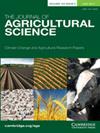Assessment of Two Calcium Silicate Sources on Cucumber Under Water Restriction
IF 1.7
4区 农林科学
Q2 AGRICULTURE, MULTIDISCIPLINARY
引用次数: 0
Abstract
Silicon (Si) is beneficial for plants that are under unfavorable conditions. In this study conducted under greenhouse conditions at Chapingo Autonomous University, Si fertilization was tested to examine whether it affected yields, biometrics, physiological parameters, and nutritional attributes of cucumber plants cultivated at different moisture levels in the substrate. Fifteen treatments were tried in a completely randomized design, including three moisture levels (50-60%, 75-85%, and 90-100% of container capacity (CC) and five Si doses (0, 50, 100 mg L-1 SiO2, 2 g L-1, and 3 g L-1 Wollastonite). Uniform irrigation was applied until the 18th day after transplantation, and controlled irrigation was applied according to the moisture levels until the end of the experiment. 3 g L-1 of wollastonite under 75-85% CC enhanced cucumber yield by 24.9% in comparison to untreated plants, while no Si dose affected fruit length, diameter, weight, and total soluble solids. At 90-100% of CC, 50 mg L-1 SiO2 increased the aerial biomass production (ABP) of the plants by 9.3%, and at 50-60% of CC, 100 mg L-1 SiO2 generated 11.8% more aerial biomass than untreated plants. As Si did not affect root production, mainly at 50-60% of CC, it improved chlorophyll a, b, and the total content of the leaves. Different parts of the plant saw significant increases in N, P, K, Ca, Mg, and Si concentrations because of Si’s interactions with moisture levels. When the substrate is low in moisture, Si is likely to improve cucumber yields, physiological, and nutritional characteristics of the plant.限水条件下黄瓜两种硅酸钙源的评价
硅(Si)对处于不利条件下的植物是有益的。本研究在Chapingo自治大学的温室条件下进行,测试了硅施肥是否影响在不同基质湿度下栽培的黄瓜植株的产量、生物特征、生理参数和营养属性。在完全随机设计中,试验了15个处理,包括3个湿度水平(容器容量的50-60%、75-85%和90-100%)和5个硅剂量(0、50、100 mg L-1 SiO2、2 g L-1和3 g L-1硅灰石)。均匀灌溉至移栽后第18天,并根据水分水平进行控制灌溉,直至试验结束。3 g L-1硅灰石在75-85% CC处理下比未处理黄瓜产量提高24.9%,而硅剂量不影响果实长、直径、重量和总可溶性固形物。在CC为90-100%时,50 mg L-1 SiO2使植物的空中生物量产量(ABP)提高了9.3%,在CC为50-60%时,100 mg L-1 SiO2比未处理植物的空中生物量增加了11.8%。由于Si不影响根系生产,主要在CC的50-60%,因此它提高了叶绿素a, b和叶片的总含量。由于Si与水分水平的相互作用,植株不同部位的N、P、K、Ca、Mg和Si浓度显著增加。当基质水分较低时,硅可能会提高黄瓜产量,提高植株的生理和营养特性。
本文章由计算机程序翻译,如有差异,请以英文原文为准。
求助全文
约1分钟内获得全文
求助全文
来源期刊

Journal of Agricultural Science
农林科学-农业综合
CiteScore
2.80
自引率
5.00%
发文量
68
审稿时长
1.4 months
期刊介绍:
The Journal of Agricultural Science publishes papers concerned with the advance of agriculture and the use of land resources throughout the world. It publishes original scientific work related to strategic and applied studies in all aspects of agricultural science and exploited species, as well as reviews of scientific topics of current agricultural relevance. Specific topics of interest include (but are not confined to): all aspects of crop and animal physiology, modelling of crop and animal systems, the scientific underpinning of agronomy and husbandry, animal welfare and behaviour, soil science, plant and animal product quality, plant and animal nutrition, engineering solutions, decision support systems, land use, environmental impacts of agriculture and forestry, impacts of climate change, rural biodiversity, experimental design and statistical analysis, and the application of new analytical and study methods (including genetic diversity and molecular biology approaches). The journal also publishes book reviews and letters. Occasional themed issues are published which have recently included centenary reviews, wheat papers and modelling animal systems.
 求助内容:
求助内容: 应助结果提醒方式:
应助结果提醒方式:


